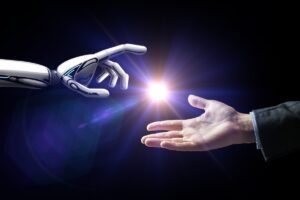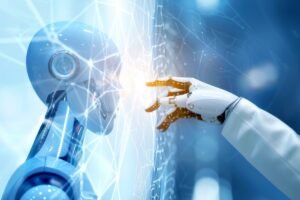Discover the real differences between machine learning vs natural language processing (NLP). Learn how they connect, their key roles in AI, and which one you should read into first.
Table of Contents
Machine Learning and NLP Explained
Hey there, welcome!
If you have ever been confused hearing people throw around terms like Machine Learning (ML), Natural Language Processing (NLP), and Artificial Intelligence (AI) you are not alone.
Today, I’m breaking it all down for you in simple, everyday English, just like we’re chatting over coffee at a Starbucks here in the States.
Let’s start into understanding Machine Learning vs Natural Language Processing, how they are connected, and why knowing both matters big time if you are stepping into the world of AI!
Read More Machine Learning ML
What is Machine Learning?
You know how kids learn by looking around and trying stuff until they get it right? Machine Learning is pretty much like that but for computers!
Machine learning is a branch of Artificial Intelligence where machines use data and statistical methods to learn things without being explicitly programmed.
Instead of coding every little thing, we feed the machine tons of data, and it figures out patterns on its own.
Some areas where Machine Learning shines:
- Computer Vision (like facial recognition)
- Robotics
- Natural Language Processing (yep, it powers NLP too)
At its core, machine learning teaches machines to solve real-world problems in ways that are similar to how you and I approach challenges but way faster and at a massive scale!
What is Natural Language Processing (NLP)?
Now, Natural Language Processing or NLP if you wanna sound fancy is all about teaching machines how you and I use language.
It’s the reason why:
- Siri understands when you ask for the weather
- Alexa can play your favorite song on command
- Chatbots can (kind of) hold a conversation with you
In simple terms, NLP transforms raw text written in human language into a format that computers can read, understand, and respond to.
NLP applications are everywhere:
- Sentiment Analysis (figuring out if tweets are angry or happy)
- Chatbots (like the helpful ones on Amazon)
- Text Classification (sorting spam emails)
Is NLP Part of Machine Learning?
Here’s where folks often get tripped up.
Is Natural Language Processing a type of Machine Learning?
Short answer: Kind of, but not exactly.
Machine learning is often used inside NLP, but NLP itself is its own subfield of Artificial Intelligence.
NLP relies heavily on machine learning to process and understand language more accurately.
There’s actually a cool relationship chart you can imagine:
Artificial Intelligence → Machine Learning → Natural Language Processing
Key Techniques in NLP Supported by Machine Learning
When we say machine learning supports NLP, here’s exactly what we mean.
To make text “machine-friendly,” NLP uses pre-processing techniques, like:
- Tokenization
(Breaking sentences into words or “tokens” super important when analyzing text!) - POS (Part of Speech) Tagging
(Marking words as nouns, verbs, adjectives, etc. helps machines know what words mean.) - Entity Extraction
(Pulling out names, places, companies, from text imagine Google Maps finding “Starbucks” automatically!) - Lemmatization and Stemming
(Turning “running” into “run” so the machine sees the root word.) - Stop Word Removal
(Kicking out words like “the,” “is,” and “have” to focus only on the important stuff.)
Each of these steps uses machine learning algorithms to clean, sort, and make sense of natural language.
Can You Learn NLP Without Machine Learning?
Here’s the deal, and I am being real with you here:
Machine learning is ESSENTIAL to mastering NLP, the same way math is essential in physics.
Without machine learning, NLP would be like trying to drive from New York to LA with no GPS you might make it, but it’s gonna be a rough ride.
Important machine learning-based techniques in NLP include:
- Bag of Words (BoW)
- TF-IDF (Term Frequency-Inverse Document Frequency)
- Word2Vec (word embeddings)
So, if you are planning to learn NLP, make sure you get comfortable with basic machine learning first. Trust me, it will make your journey a whole lot smoother!
How Deep Learning Enhances NLP
Alright, now there’s another cool kid in the AI neighborhood Deep Learning.
Deep learning is actually a subset of machine learning that uses artificial neural networks basically mimicking how our brains work.
Deep learning has supercharged NLP, allowing:
- Better language translation
- Smarter chatbots
- More accurate speech recognition
Tools like BERT, GPT (yep, me! ), and Transformer models would not exist without deep learning.
Read More Natural language processing
Deep learning helps machines:
- Understand context better
- Catch sarcasm and emotions more accurately
- Handle bigger data sets without getting confused
FAQs About Machine Learning and NLP
Q. Is NLP a type of Machine Learning?
Ans. Not exactly. NLP is a subfield of AI that uses machine learning to process and understand language.
Q. Can I learn NLP without learning machine learning?
Ans. Technically possible, but not recommended. You’ll miss out on the most powerful techniques.
Q. What are real-life examples of NLP?
Ans. Chatbots, Siri, Alexa, Gmail’s spam filters, and even autocorrect on your iPhone!
Q. Is deep learning necessary for NLP?
Ans. For simple tasks, no. But for advanced tasks like chatbot conversations and voice assistants absolutely yes!
Conclusion
Alright, to wrap it up in plain English:
- Machine Learning is like the brainpower that lets machines figure things out from data.
- Natural Language Processing is how machines talk and understand human language.
Machine learning supports NLP.
NLP needs machine learning to truly work well.
And deep learning?
It takes everything to the next level by making machines smarter, faster, and more human-like in language tasks.





Pingback: Reinforcement Learning Revolutionizing Healthcare Education in 2025